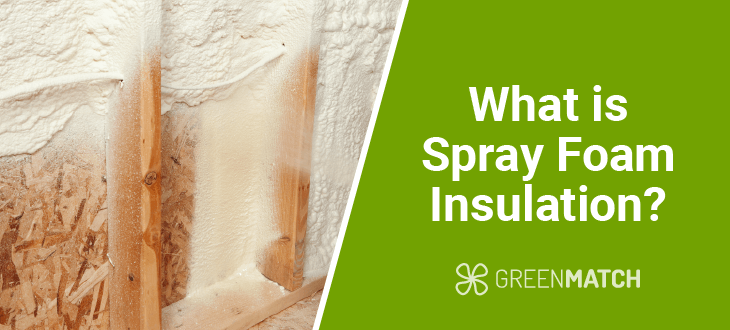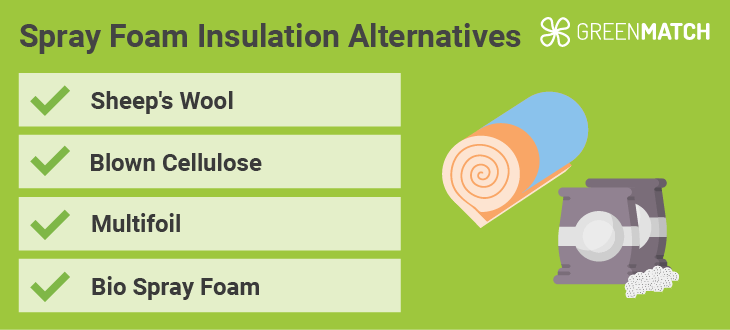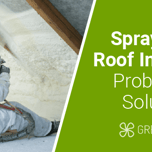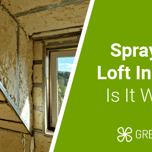
Get Free quotes from loft conversion specialists near you

Save money by comparing quotes and choosing the most competitive offer

The service is 100% free and with no obligation
- GreenMatch
- Insulation
- Spray Foam Insulation
Your Ultimate Guide to Spray Foam Insulation


- Spray foam is renowned for its high thermal performance, exhibiting some of the highest R-values of all insulation materials.
- Spray foam is often used for cavity walls, lofts, and underfloor insulation. Its versatility makes it useful for a wide range of home insulation applications.
- Polyurethane foam costs around £21.5 per m2, excluding installer labour costs.
Spray foam insulation - or polyurethane foam - is arguably one of today's most effective thermal insulation materials. This versatile expanding foam is used for many insulation jobs and can fill cavities with an airtight finish, boosting a home’s heat retention.
Despite its highly impressive performance, spray foam insulation also has its fair share of pros and cons that are important to consider. This ultimate GreenMatch UK guide will walk you through everything you need about spray foam insulation, including costs, applications, grants, and alternatives.
Ready to insulate your home? Look no further than GreenMatch UK for all your needs. Instead of spending countless hours researching and vetting installers, spend just 30 seconds filling out our online form and receive up to 3 free home-tailored quotes. Click the button below to begin!
Fill in the form in just 1 minute
What is insulation foam?
Polyurethane spray foam is a spray-applied expanding plastic foam that works as an air barrier and excellent thermal insulator. The impermeable nature of this foam filler makes it a great material to seal cracks and gaps, as well as insulate walls, floors, lofts and ceilings against air movement.
When looking at spray foam insulation, you’ll likely come across two main types:
- Open-cell spray foam insulation is common for domestic homes. It’s a lightweight, spongy insulation material that is applied to open wall cavities, lofts, and ceilings. It remains quite soft after application and is known to regulate a constant home temperature while creating an airtight seal.
- Closed-cell spray foam insulation is common with commercial properties. It’s a slowly expanding, spray-applied polymer that is high-density and durable. Closed-cell spray foam becomes very tough and rigid after application, has excellent heat resistance properties and creates a barrier that reduces air transfer.
In both cases, polyurethane spray foam is spray-applied by a professional installer using industry equipment. For this reason, it’s important to work with an accredited professional who can conduct the necessary property assessment, prep work, and installation to a high quality.
Spray foam insulation cost

The cost of spray foam insulation is around £21.5 per m2 (£1.99 per ft2) however can range as far as £50 per m2 (£4.64 per ft2) depending on the density and quality. Overall insulation prices hinge on several factors, such as your home's conditions, accessibility, location, any existing insulation and more.
Despite the higher cost of spray foam insulation, its durability, longevity, and excellent thermal retention can lead to long-term savings and decades of home comfort. Here’s a breakdown of the average cost range for spray foam insulation, as well as the potential payback period on your investment:
| Property type | Property size (m2) | Average price (100mm thickness spray foam) | Average payback period |
|---|---|---|---|
| 3 bedroom house | 100 | £4,500 | 9 years |
| 2 bedroom house | 65 - 70 | £3,150 | 7 years |
| Bungalow | 70 - 75 | £3,375 | 7 years |
In addition, 100mm thickness foam insulation can bring about massive savings on your energy bills. How much you save depends on your home type and what you are insulating, but we’ve detailed the expected savings per house insulation approach you can expect for a standard 3-bedroom semi-detached home in the UK:
| Insulation type | Average savings (£/y) | Average CO2 cut (kgCO2/y) |
|---|---|---|
| Cavity wall | £210 | 650 |
| Solid wall | £290 | 900 |
| Floor | £60 | 190 |
| Loft | £200 | 600 |
With this considered, spray foam insulation does emerge as a highly effective means of curbing your annual energy costs and improving your home's comfort.
Spray foam insulation removal cost
A key point to remember about spray foam insulation is its messy, labour-intensive, and expensive removal process. So much so, that in most cases, spray foam removal costs are far higher than getting spray foam insulation in the first place!
Some homes may have outdated or damaged spray foam insulation that needs to be removed before adding new insulation. The process takes place by a removal team, who manually cut away the spray foam insulation as close to the original surface as possible without damaging the home's integrity. Then, the rest of the foam is removed by hand.
Here’s what you could roughly expect to pay for spray foam insulation removal if you live in a standard 3-bedroom semi-detached house:
| Job | Cost |
|---|---|
| Foam insulation removal full job (loft) | £3,200 |
| Foam insulation removal per m2 (loft) | £40 |
These costs may fluctuate depending on the complexity of the job, your location and other conditions, but as can be seen, spray foam insulation removal is no cheap task.
Applications of spray foam insulation
Spray foam insulation is highly versatile because of its liquid-expanding form. This way, it can be used to fill in practically any crevices and openings and shape around awkward areas of your home.
Here are some of the main areas your house can be insulated with using spray foam insulation:
Roofs
Warm roof insulation is when the underside of your home's roof is insulated to keep your loft area - alongside the rest of your house - temperature-regulated. This approach is most suitable for homes that plan to use their loft area as a living space, not just storage space.
For attic spray foam roof insulation, installers will apply the spray foam to the roof rafters from the underside of your roof for an airtight seal, leading to thermal insulation throughout the rest of your home. The best loft insulation approach will depend on what you want to use your loft for.
Lofts
Cold loft insulation is when the loft floor is insulated to keep the rest of your house under your loft warm. The choice of how to insulate a loft depends on your needs. This approach is best if you do not plan to use your loft space for living, but just for storage.
For spray foam loft insulation, installers will lift your loft floorboards and apply spray foam in between and over the floor joists before re-attaching the floorboards, providing adequate insulation for the rest of your house.
Underfloor
Similar to loft insulation, underfloor spray foam insulation is done by lifting floorboards, spraying insulation in between and over floor joists, and re-attaching the floorboards. It’s important to note that this form of insulation is only suitable for suspended timber floors, or floors with a cavity space under them.
Solid concrete floors could rather use an alternative insulation approach, such as rigid insulation boards.
Cavity wall
Spray foam cavity wall insulation can be applied to new builds before the cavity is sealed, or old builds by drilling entry holes into the cavity space through the outer wall. It’s important to note that foam wall insulation can only be carried out by a professional installer and is not DIY suitable.
An installer will drill small evenly spaced holes from the outer wall to access the cavity space, and inject spray insulation into the cavity with specialised industry equipment. The holes will then be sealed with cement for a seamless finish. This form of wall insulation is mess-free, non-invasive, and takes just a few hours to complete.
Advantages of spray foam insulation

You might be wondering; is spray foam insulation good? Spray foam insulation is no doubt one of the most thermally effective insulation materials available on the market today.
Here are just a few of the key advantages you can experience with spray foam insulation:
- Thermally effective: Spray foam insulation has some of the most impressive thermal qualities of any insulation material on the market. With a steller r-value, it's one of the highest returns on investment insulation materials.
- Long lifespan: Spray foam insulation can last an excess of 80 - 100 years if installed properly, giving it one of the longest lifespans of any insulation material. Important to note, that this very much depends on the quality of the installation.
- Huge savings: A proper spray foam insulation job can bring your home massive energy bill savings, reducing your energy and financial insecurity while drastically improving your home's inner comfort.
- Fast payback: Given spray foam insulations’ high performance, this insulation upgrade - while expensive - tends to still have a reasonable payback period, depending on your home size, conditions and installation complexity.
Spray foam insulation problems and how to overcome them

Like any insulation material, spray foam insulation has its fair share of cons worth considering. However, by working with a National Insulation Installer that is professional and accredited, rest assured you can avoid most of them.
Regardless, you may have heard plenty of backlash and wondered; why is spray foam insulation bad? Here are some disadvantages of spray foam insulation you should consider when planning to install some:
- Ventilation issues: Spray foam insulation creates an impenetrable air barrier. While this may seem great for insulation, it limits healthy air circulation and creates the risk of moisture, mould and rot. This is especially true for timber frame houses that can experience structural damage.
- Moisture issues: Relating to ventilation, moisture buildup can become an issue with spray foam that does not have ventilation accounted for. For example, cavity walls can experience inner wall moisture as the foam creates a bridge with the outer wall, allowing moisture to leech through.
- Chemical off-gassing: Perhaps the most concerning, spray foam is made from synthetic polyurethane, a chemical component that off-gases harmful VOCs (volatile organic compounds). These can be damaging to your health and exacerbate respiratory issues.
- Property value damage: In many cases, houses with spray foam insulation are less desirable in the housing market. This is because spray foam insulation removal is a highly costly, laborious and messy process that can potentially damage a home.
Most of these problems can be addressed with a professional installer who uses high-quality materials, accounts for ventilation, and carries out high workmanship.
Spray foam insulation mortgage problem
Homeowners around the globe often ask themselves; should I buy a house with spray foam insulation? Let’s look at some of the mortgage problems of this decision.
Spray foam insulation is a double-edged sword. On one end, its robust, durable nature makes it a solid choice once installed, but on the other end, it becomes an absolute nightmare to remove, both financially and labour-wise. This is especially true for poor-quality installations.
As such, many households that have pre-existing spray foam installed may take a negative hit in the housing market. Prospective renters and buyers are reluctant to invest in a house with spray foam, given the inevitable need to one day remove and replace the material.
However, there are some key steps you can take to minimise this risk as much as possible:
- Homeowners: Work exclusively with a professional installer and avoid handling the job of DIY spray foam insulation no matter what. DIY installation may be financially tempting in the short term, but can turn into a financial/safety disaster in the long term.
- Prospective buyers: Avoid renting or purchasing homes with DIY spray foam installation, or at least, ensure that the insulation has been properly assessed. Make sure to check everything and properly get advice from a realtor.
While it’s generally advised to avoid spray foam insulation, certain mortgage lenders accept spray foam insulation properties. The Home Owners Association (HOA) claims that certain criteria about the type and condition of spray foam need to be met.
Most mortgage lenders may even require an inspection of the insulation and make mortgage calculations based on this decision.
Is spray foam insulation worth it?
With all things considered, spray foam insulation is worth it if you are sure to make the right decisions with your installation.
Doing everything by the book, working with a professional installer, and paying for high-quality materials can get you a massive return on your investment and 80 - 100 years of home comfort.
On the other hand, a DIY job, or working with an inexperienced installer can result in painstaking repair costs, significant home damage, and structural issues that plague your home for years to come.
Spray foam insulation grants
In a bid to become carbon neutral by 2050, the UK government has rolled out two key insulation grants that assist fuel-poor, low-income, and energy-inefficient homes with insulation upgrades, including spray foam insulation.
These schemes are the Great British Insulation Scheme (GBIS) and the Energy Company Obligation (ECO4). Both are active until March 2026 and exist to provide free and reduced-cost insulation upgrades to qualifying households.
Eligibility is generally based on your status as a low-income household. Things such as your council tax bands, your home's Energy Performance Certificate (EPC) rating, and whether you’re a recipient of government benefits are gauged for eligibility.
To learn more about spray foam insulation grants, or the GBIS scheme, you can visit the UK government website directly and fill in the application form. For the ECO4 scheme, you can get into direct contact with your energy supplier to learn more about the application process.
Alternatives to expanding foam insulation

With all things considered, spray foam remains a questionable insulation choice. On one hand, it exhibits some of the best thermal performance of all insulation materials, on the other hand, it’s a very difficult removal process that can potentially damage your home beyond repair.
For this reason, it’s wise to consider alternatives to spray foam insulation that are safer, more environmentally friendly, and cheaper. Here are some solid competitors worth a thought:
- Sheep's wool: As an all-natural material, sheep's wool exhibits impressively high thermal insulation properties as well. Additionally, it is entirely hypoallergenic, contains no harmful chemicals, and is fully recyclable.
- Blown cellulose: This budget-friendly material is made entirely from recycled paper and wood products, making it incredibly sustainable. It’s fully recyclable, contains no harmful chemicals, and can be applied using a special spray hose.
- Multifoil insulation: Made from layers of aluminium bonded with spray foam, this affordable material combines the desirable qualities of insulation without the detrimental effects of spray foam for just a fraction of the cost. Plus, it's easy to remove!
- Bio spray foam insulation: While less common to come by, several bio-friendly spray foams are chemical-free. Some examples are Icynene foam, which is castor oil-based, or Soy foam, made primarily from soybean. Impressively, both bio alternatives still exhibit very impressive thermal properties.
Regardless of the material you choose, the most important step is to work with professional spray foam insulation contractors to make sure the job is done correctly. The best way to land a bargain is to get multiple quotes from installers to find your best fit.
Sadly, not everyone has endless hours for dedicated researching and vetting spray foam insulation companies online, but that's where GreenMatch UK can help you out.
Through our services, you can get 3 free home-tailored quotes from our network of highly qualified installers. No charges or obligations. Simply fill in our 30-second form and let the bargains come to you. Click the button below to begin!
Fill in the form in just 1 minute
FAQ
The safety of spray foam insulation is debatable. While it’s flameproof and thermally effective, spray foam is known to hold the risk of off-gassing harmful chemicals and volatile organic compounds (VOCs). These can increase the risk of respiratory illnesses.
Spray foam insulation, like any insulation material, has its downsides. Its capacity to create an impermeable air barrier can create ventilation issues, leading to moisture, mould and structural rot in your home. Additionally, spray foam insulation is highly complex, costly, and laborious to remove.
It is not advised to carry out spray foam insulation DIY, both for safety purposes and to ensure a high-quality insulation job takes place. Working with an accredited installer can make sure the job is carried out with professionalism, helping you avoid experiencing the cons of spray foam.
It’s important to consult with a housing professional before deciding to buy a house with preexisting spray foam insulation. This is because poor spray foam insulation is very expensive to remove, often costing more than the installation process itself.
There are very few mortgage lenders who will consider housing that contains spray foam insulation. In most cases, you still need to undergo extensive contracting, referrals and long-term guarantees to secure a mortgage loan. Working with a professional financial advisor can help find some guidance in this direction.

Akif is a copywriter at GreenMatch since 2023. With a keen interest in community sustainability, green solutions and the role of digital media in identifying climate trends, he aims to hone in on his background in International Studies and Digital Media to provide a multidisciplinary approach to written content rooted in credible research and accuracy.
We strive to connect our customers with the right product and supplier. Would you like to be part of GreenMatch?



